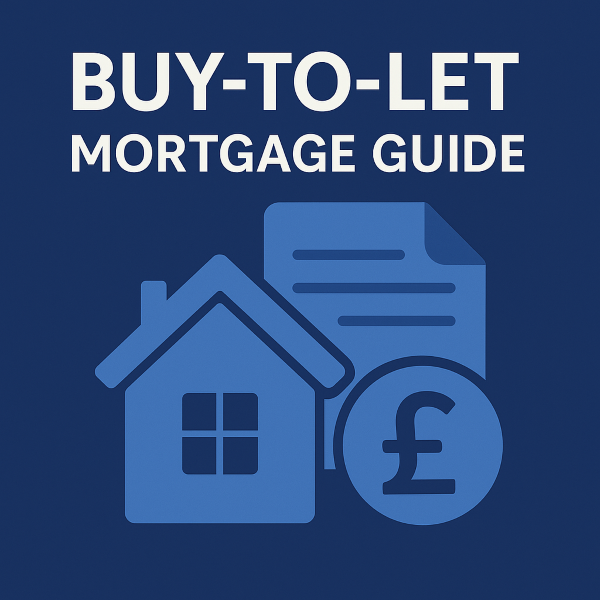Buy-to-Let Mortgage Guide | A buy-to-let mortgage is a loan for a property you intend to rent out rather than live in. This guide explains how UK landlords can find the right buy-to-let mortgage, avoid common pitfalls and maximise returns. You will learn eligibility criteria, deposit and rate rules, tax implications and key risks.
What Is a Buy-to-Let Mortgage?
A buy-to-let mortgage is a loan used to purchase a property you plan to rent to tenants. You will not live in the property yourself, so lenders treat the application differently from a standard residential mortgage. Lenders assess affordability using the expected rental income, not only your personal salary or employment income. Most lenders expect rental income to cover at least 125 to 145 per cent of the interest payments. Buy-to-let mortgages often use interest-only terms, which keep monthly payments lower for property investors.
The loan balance normally gets repaid when you sell or refinance the property at the end of the term. These mortgages usually require a larger deposit, often between 20 and 40 per cent, because letting property carries a higher risk. Interest rates are also higher than standard residential rates for the same reason. Buy-to-let mortgages suit landlords who want long-term rental income or capital growth from property investment.
Eligibility Criteria for UK Landlords
| Criteria | Requirement | Details |
|---|---|---|
| Minimum Deposit | 20–25 per cent | Most lenders require at least a 20–25 per cent deposit. |
| Higher Deposit Cases | 30–40 per cent | Higher-risk cases often need a 30–40 per cent deposit. |
| Rental Income Coverage | 125–145 per cent | Rent must cover 125–145 per cent of the monthly interest costs. |
| Interest Cover Ratio | Required by all lenders | This test ensures rent supports the mortgage payments. |
| Personal Income | £25,000+ per year | Many lenders require a minimum personal income of £ 25,000. |
| Lower Income Cases | Specialist review | Some lenders accept less if rental yield is strong. |
| Portfolio Landlord Status | Four+ mortgaged properties | Owning four or more rentals classifies you as a portfolio landlord. |
| Portfolio Checks | Stricter assessments | Lenders review rental income, values and all property loans. |
| Experience Requirements | Case-by-case | Some lenders want landlord experience, especially for HMOs. |
| Credit History | Must be clean | Applicants need a stable credit record and no recent arrears. |
| Property Type Rules | May vary by lender | Flats above shops, HMOs or holiday lets need specialist lenders. |
How Much Can You Borrow?
Lenders decide how much you can borrow by assessing the property’s expected rental income. They also apply a stress-tested interest rate to check affordability during rate increases.
Most buy-to-let mortgages allow a maximum loan-to-value (LTV) of 75 per cent for standard applications. Some specialist lenders may offer 80 per cent or 85 per cent LTV for strong cases.
Your borrowing limit depends on your rental income, deposit size and overall financial position. Many lenders require the rental income to cover 125 to 145 per cent of the monthly interest payments.
This is known as the Interest Coverage Ratio (ICR) and it protects lenders against rent shortfalls. Higher personal income or stronger credit history can also increase your borrowing potential.
Most buy-to-let mortgages use interest-only terms because they keep monthly payments low. Interest-only terms help landlords manage cash flow, especially during early investment stages.
Capital repayment mortgages are available, but they increase monthly payments significantly.
Speak to a buy-to-let mortgage adviser to understand which structure suits your investment goals. Use our Connect Mortgage Broker Directory to compare buy-to-let advice and mortgage options.
Deposit and Rate Considerations
Larger deposits typically result in higher interest rates. If you put down 40 %+ you may access more favourable deals. Interest rates for buy-to-let mortgages are typically higher than those for residential mortgages due to the increased risk to lenders.
Tax, Costs & Landlord Obligations
As a landlord, you must budget for:
-
Stamp Duty surcharge on additional properties (usually +3 %).
-
Income tax on rental profits and possible capital gains tax when selling.
-
Buildings and landlord insurance plus regulatory costs (EPC, gas safety certificates etc).
(Internal link: check our article on tax implications for landlords.)
Risks and Things to Check
-
Rental void periods reduce cash flow, so build a buffer for unexpected costs.
-
Interest rates may rise after fixed periods—plan for this scenario.
-
Property type matters: leasehold, flats above certain buildings or HMOs may require specialist approval.
-
Always ensure your broker is FCA-authorised and offers whole-of-market advice. (Internal link: see connect mortgage broker directory for vetted advisers.)
Step-by-Step Guide to Getting a Buy-to-Let Mortgage
-
Clarify your investment goal (single property vs portfolio).
-
Review your personal income, credit history and available deposit.
-
Research the rental market in your chosen area and estimate yield.
-
Speak to a specialist buy-to-let mortgage broker.
-
Choose a property, apply for a mortgage offer, and budget for all associated costs (purchase, setup, legal, and maintenance).
-
Manage the property responsibly to maintain returns and compliance.
Ready to explore your buy-to-let mortgage options? Use our Connect Broker Directory to find a specialist, FCA-authorised adviser who understands the UK rental market and can guide you through every step.
Thank you for reading our “Buy-to-Let Mortgage Guide UK | Everything Landlords Must Know” publication. Stay “Connect“-ed for more updates soon!

